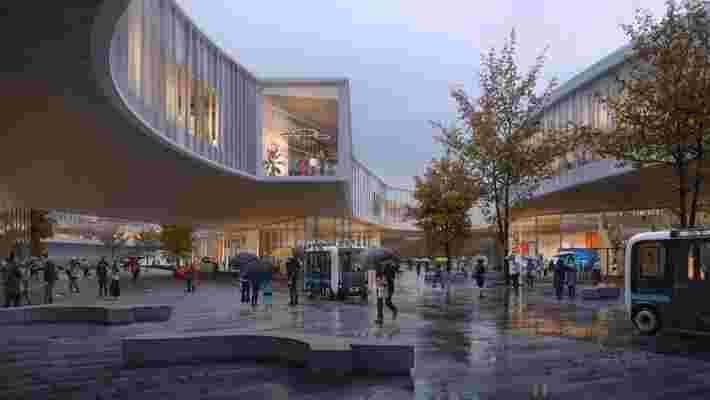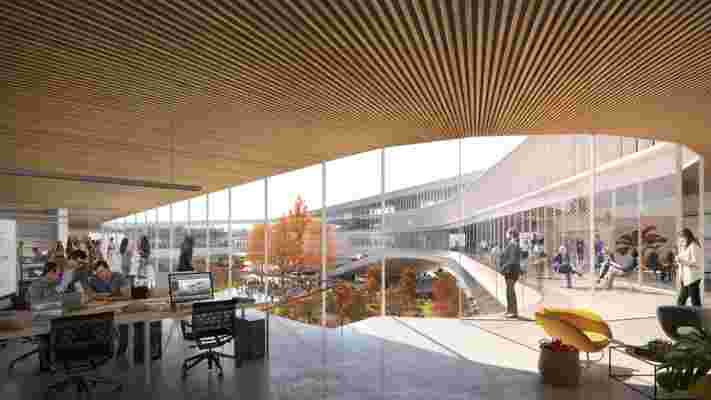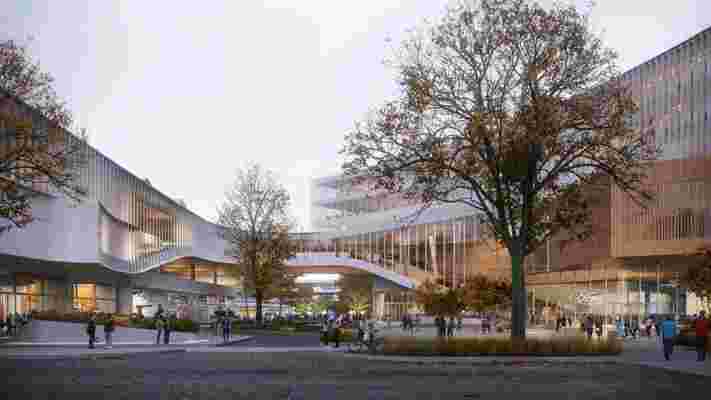Can a corporate campus inform city planning? That's the question proposed by AD100 firm Snøhetta's latest master plan—a future-forward update to the Ford Motor Company's research and engineering complex in Dearborn, Michigan. The 350-acre site has not undergone a holistic rethinking since 1946, when Henry Ford II laid out the vision for the company's first campus dedicated to R&D in this industrial city in the south of its state. Now, the recently unveiled master plan, for which Snøhetta was also hired as lead architect and landscape designer, attempts to move the company into the 21st century and beyond with a multimodal, habitat-centered, and public-facing approach.

The master plan suggests that a multimodal yet pedestrian-oriented campus is key to ensuring use through generations.
When thought turns to contemporary corporate campuses, visions of the highly secretive, impenetrable behemoths may come to mind. Perhaps their series of towers, or a spaceship-esque ring, is integrated into a park. Perhaps they’ve built their own pier. In any case, flexible interior spaces within a flashy design are top priority.
Snøhetta works differently. “There are plenty of people that can make nice buildings. We are making an ecosystem,” explains principal Craig Dykers of the layered plan his design and landscape teams have set forth after two years of research and planning work with Ford. Though required to accomplish just three basic goals—consolidate Ford employees currently strewn across Dearborn, optimize team adjacencies, and increase opportunities for collaboration—the master plan improves the workplace far beyond its call.

All workspaces are versatile as a means of future-proofing their use. “It’s fundamentally creating good space,” says Snøhetta principal Craig Dykers. “The most useful spaces have good daylight and comfortable proportions.”
It’s conceived as a living laboratory for mobility, with streets and buildings designed for our current crossover period in technologies but able to accommodate the future. Traditional cars still dominate our nation’s roads, but self-driving vehicles are making quick headway in popularity, so the design team reimagines internal streets on the new Ford campus as pedestrian-prioritizing open spaces shared by walkers, bicyclists, minibuses, and autonomous and driver-controlled cars. Likewise, its mostly interconnected offices are designed for versatile uses, a research space today could become a design studio in the future while maintaining its fundamental building blocks: daylight and comfortable proportions. Buffer zones between structures have been planned for new or reshaped buildings, whose need may arise as new discoveries are made. “It’s sort of a blank canvas for that,” says project director Nathan McRae. “It allows different technologies to be used over time and has the variability for experimentation without overcommitting to anything now.”

Interconnected buildings allow for team adjacencies on a campus that will consolidate 20,000 employees when fully realized.
The campus will also be a better neighbor, more porous and generous than currently. The surrounding context informs its massing, which builds up density at the side of the site that touches a heavily trafficked street (where the test track is located). And the site itself is all public; layers of security protect entrances to office buildings, while retail spaces activate many of their ground-floor perimeters. Near the residential-adjacent end, a new park will meander in a natural floodplain, now topped by parking lots. During their site evaluation and research, the Snøhetta landscape team discovered savannah, woodlands, and a cedar maple forest had once thrived here and will be reestablished based on natural drainage patterns. Overall, building area will increase by 3% while open space will increase by 29%.
At the residential-adjacent end of the master-plan site, the Snøhetta landscape team plans to reinstate the natural savannah and woodlands that had been paved over by parking lots.
Integrating habitat and industry into a semi-public site may seem the obvious solution for a campus that spans the equivalent of several neighborhoods; however, the history of corporate campus planning shows that an environmentally gentle and friendly approach is not the norm. Yet that is changing, according to Dykers. “Ford, like many other companies, has realized that we have to have greater sensitivity for the impact of the things that we create,” he says. “This is also true in the architecture industry where we can’t just build a building and say that we are done. Buildings have an effect on society, on climate, on national landscapes.” In addition to making changes in how colleagues interact amongst themselves and with their surroundings, the scale of the master plan suggests processes that can be applied more broadly. Says Dykers, “Hopefully, if we are very successful, people will see this as how you can plan future cities better.”
